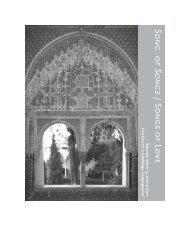BH1001, Guillaume Du Fay: Motets - Blue Heron
BH1001, Guillaume Du Fay: Motets - Blue Heron
BH1001, Guillaume Du Fay: Motets - Blue Heron
Create successful ePaper yourself
Turn your PDF publications into a flip-book with our unique Google optimized e-Paper software.
of the opening to the plangent cadence on the<br />
modal final of E. When the emotion is as heartfelt<br />
as it is here, I think we must acknowledge that<br />
medieval people felt the pains of love as acutely<br />
as we, and find our entry into the poetry by way<br />
of the emotional power of the music to which<br />
it is set. That we are able to connect with music<br />
more than five hundred years old is itself clear<br />
evidence of what Page calls “a ‘transhistorical<br />
humanness’: an appreciable continuity of human<br />
thought and feeling from age to age.” 6<br />
Flos florum<br />
Flos florum is an odd work out on our program,<br />
for it is a sacred text set to music in the<br />
usual chanson format of three voices, with one<br />
higher voice (discantus) and two lower parts<br />
in the same range (tenor and contratenor).<br />
Flos florum features a virtuosic discantus, duet<br />
passages between discantus and contratenor,<br />
and a concluding section of striking harmonies,<br />
each marked by a “corona.” Nowadays this sign<br />
is known as a fermata and indicates an unmeasured<br />
hold, but in <strong>Du</strong> <strong>Fay</strong>’s time it probably signalled<br />
the singers to improvise ornamentation, 7<br />
and we have seized the opportunity to do so.<br />
Ockeghem<br />
In a nod to the generation after <strong>Du</strong> <strong>Fay</strong>, we<br />
include a song attributed to Ockeghem. 8<br />
Permanent vierge combines a forme-fixe French<br />
rondeau with two Latin-texted cantus firmi,<br />
both Marian antiphon chants, in a hybrid form<br />
known nowadays as a motet-chanson. The<br />
French poem glosses the text of yet another<br />
antiphon, Mulier amicta sole, which the fifteenth-century<br />
scribe wrote sideways in the<br />
margin of the manuscript. The words are from<br />
Revelation 12:1: “And there appeared a great<br />
wonder in heaven; a woman clothed with the<br />
sun, and the moon under her feet, and upon<br />
her head a crown of twelve stars.” Written for<br />
five voices, Permanent vierge is an astonishing<br />
and gorgeous work whose only fifteenth-century<br />
antecedents outside of Ockeghem’s own<br />
creation are three surviving motet-chansons<br />
by his elder friend and colleague, <strong>Du</strong> <strong>Fay</strong>.<br />
Performance practice<br />
There is general agreement among scholars<br />
of fifteenth-century music that parts with<br />
texts were normally sung, and that polyphony<br />
whose sources include texted parts was also<br />
sometimes played by purely instrumental<br />
ensembles. Beyond this there is not much<br />
about the performance of this repertoire that<br />
does not pose a question to be pondered by<br />
the present-day musician.<br />
A choir in the fifteenth century could be as small<br />
as three or four men, or as large as a dozen or<br />
more. The top part of sacred polyphony was<br />
usually sung by adult male falsettists, but occasionally<br />
boys might replace them. Polyphony<br />
might be performed by soloists or by larger<br />
ensembles with more than one voice to a part;<br />
9



